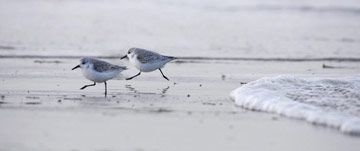Sanderling (Calidris alba)

Sanderling © Richard Steel
Sanderlings are only normally found at the tide-edge on sandy shore, for this is the little bird that follows each wave in and out like a clockwork toy, picking small shrimps from the water. At low water they sometimes feed on tiny molluscs and at high tide they may search along the strand line of seaweed for sandhoppers and small flies.
Sanderlings have always been more common on passage in spring and autumn than in winter, but the species has obviously changed its wintering habits quite recently. A century ago it was a scarce winter resident (Coward 1910), and Hardy (1941) wrote of ‘a few seen in winter’, with Bell (1962) stating that it was irregular in numbers and appearances in the Dee estuary, never more than fifty and often considerably fewer. The first mention in a Cheshire Bird Report was in 1971 when 267 Sanderlings were on the Dee in January, so obviously numbers had risen rapidly, with 642 a year later in January 1972, but it was December 1989 before a higher winter count was recorded, of 823 birds. There were then several winters with large flocks, 1,010 on 18 November 1990 and 1,581 on 19 January 1992, but only just over 300 in the following winter: large fluctuations from one year to the next are a feature of this species. After another four-figure maximum in winter 1994/ 95 numbers fell to peak usually in the range 200-400 birds until another winter WeBS count of over 1,000 birds came in 2005/ 06. It has to be said, sadly, that the Cheshire and Wirral bird reports never distinguish how many of the Dee estuary birds were actually in the county, and Sanderlings have often favoured the Welsh side of the river.
The records in this Atlas are, therefore, particularly valuable, with counts on a variety of dates in 2004/ 05 including 405 at Hilbre (SJ18Z), 1,000 at West Kirby (SJ28C) and 560 on Hoylake shore (SJ28E). The following winter, 2005/ 06, a large flock of 3,000 was reported from Hilbre, with 600 on Hoylake shore, and in 2006/ 07 600 were counted at Hilbre. Birds are concentrated mostly around the northwest corner of Wirral, with the highest count farther east being just 40 birds at New Brighton (SJ29W). Birds away from the north Wirral shore are unusual, including the flock of twenty feeding on the Mersey shore off Hale lighthouse (SJ48Q) on 27 January 2006.
Sanderlings breed on the Arctic tundra, with birds visiting western Europe from northeast Greenland, Svalbard and Siberia. Many birds end up wintering in Africa but the origins and movements of the different populations are still not clear although it is thought that birds from the northwest just pass through on passage and that those from Svalbard and Siberia are likely to winter here (Migration Atlas). The picture is further complicated by some individuals that arrive here in July or August and moult before moving on, some of these birds often staying into the early part of winter in the second half of November. The winter population of the Dee has been little studied but Merseyside Ringing Group has many distant records from birds ringed on passage through the estuary, from Russia and Iceland to the north to Malta and fifteen birds in Africa, the farthest south being two in Ghana.
Despite the enormous year-to-year fluctuations detailed above, which are seen at many sites in Britain, birds are said to be very faithful to wintering and passage sites (Migration Atlas), suggesting that changing proportions of juvenile birds might account for the variations in numbers. The Dee estuary consistently holds more than 1% of the British wintering population of Sanderlings (210 birds) and thus qualifies as nationally important for the species, but it would be good to have more understanding of the winter habits of this enigmatic bird.
Sponsored by Sheila Blamire

